Inclusive Education (EST 523) Assignment 02: Autism Case Study
VerifiedAdded on 2020/01/15
|38
|7082
|727
Case Study
AI Summary
This case study provides a detailed analysis of a child with autism, focusing on the challenges and difficulties faced within an inclusive education setting. The report includes a comprehensive literature review, the child's case history, and the mother's report, offering insights into the child's development and the impact of autism. It explores the causes, strengths, weaknesses, and difficulties associated with autism, alongside a review of national and international developments in autism support. The study presents classroom observations, highlighting communication barriers and participation issues. An Individualized Education Plan (IEP) with long- and short-term goals is included, along with recommendations. The study underscores the importance of special education needs (SEN) and the support provided by various organizations to children with autism. The report concludes with a discussion of the observations and the effectiveness of the educational approach. This assignment provides a valuable resource for understanding autism and its impact on education.
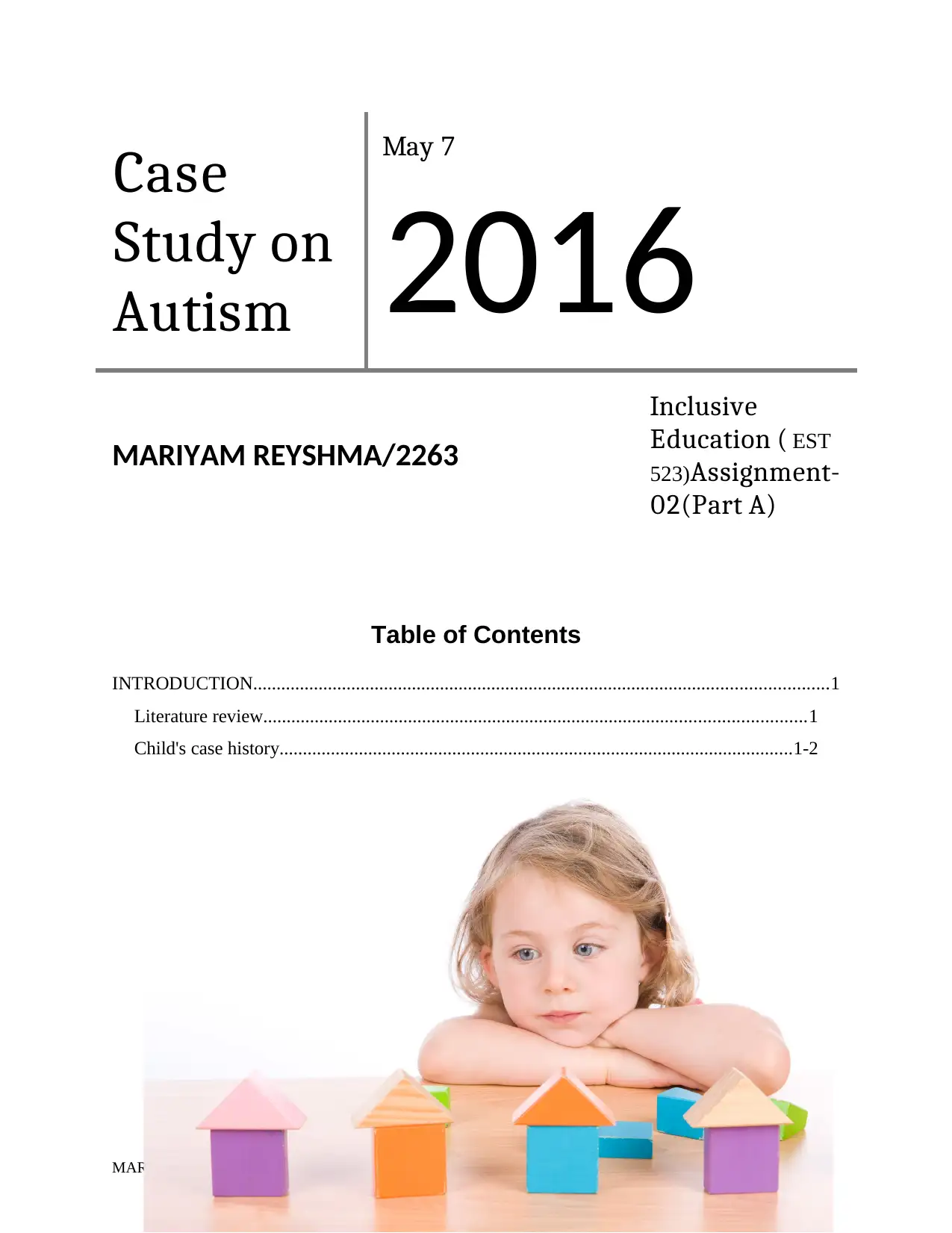
Case
Study on
Autism
May 7
2016
MARIYAM REYSHMA/2263
Inclusive
Education ( EST
523)Assignment-
02(Part A)
Table of Contents
INTRODUCTION...........................................................................................................................1
Literature review....................................................................................................................1
Child's case history..............................................................................................................1-2
MARIYAM REYSHMA/2263
Study on
Autism
May 7
2016
MARIYAM REYSHMA/2263
Inclusive
Education ( EST
523)Assignment-
02(Part A)
Table of Contents
INTRODUCTION...........................................................................................................................1
Literature review....................................................................................................................1
Child's case history..............................................................................................................1-2
MARIYAM REYSHMA/2263
Paraphrase This Document
Need a fresh take? Get an instant paraphrase of this document with our AI Paraphraser
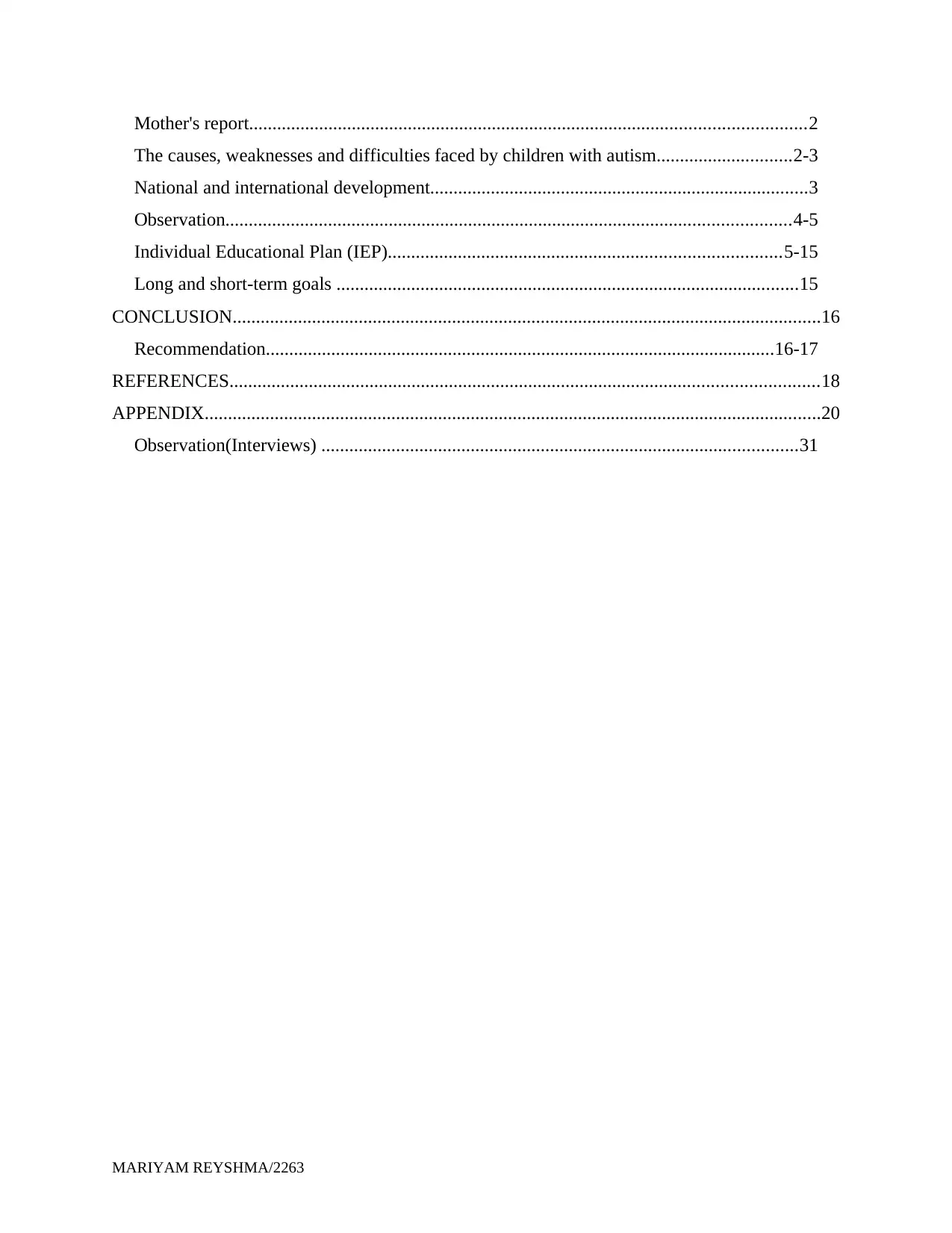
Mother's report.......................................................................................................................2
The causes, weaknesses and difficulties faced by children with autism.............................2-3
National and international development.................................................................................3
Observation.........................................................................................................................4-5
Individual Educational Plan (IEP)....................................................................................5-15
Long and short-term goals ...................................................................................................15
CONCLUSION..............................................................................................................................16
Recommendation.............................................................................................................16-17
REFERENCES..............................................................................................................................18
APPENDIX....................................................................................................................................20
Observation(Interviews) ......................................................................................................31
MARIYAM REYSHMA/2263
The causes, weaknesses and difficulties faced by children with autism.............................2-3
National and international development.................................................................................3
Observation.........................................................................................................................4-5
Individual Educational Plan (IEP)....................................................................................5-15
Long and short-term goals ...................................................................................................15
CONCLUSION..............................................................................................................................16
Recommendation.............................................................................................................16-17
REFERENCES..............................................................................................................................18
APPENDIX....................................................................................................................................20
Observation(Interviews) ......................................................................................................31
MARIYAM REYSHMA/2263
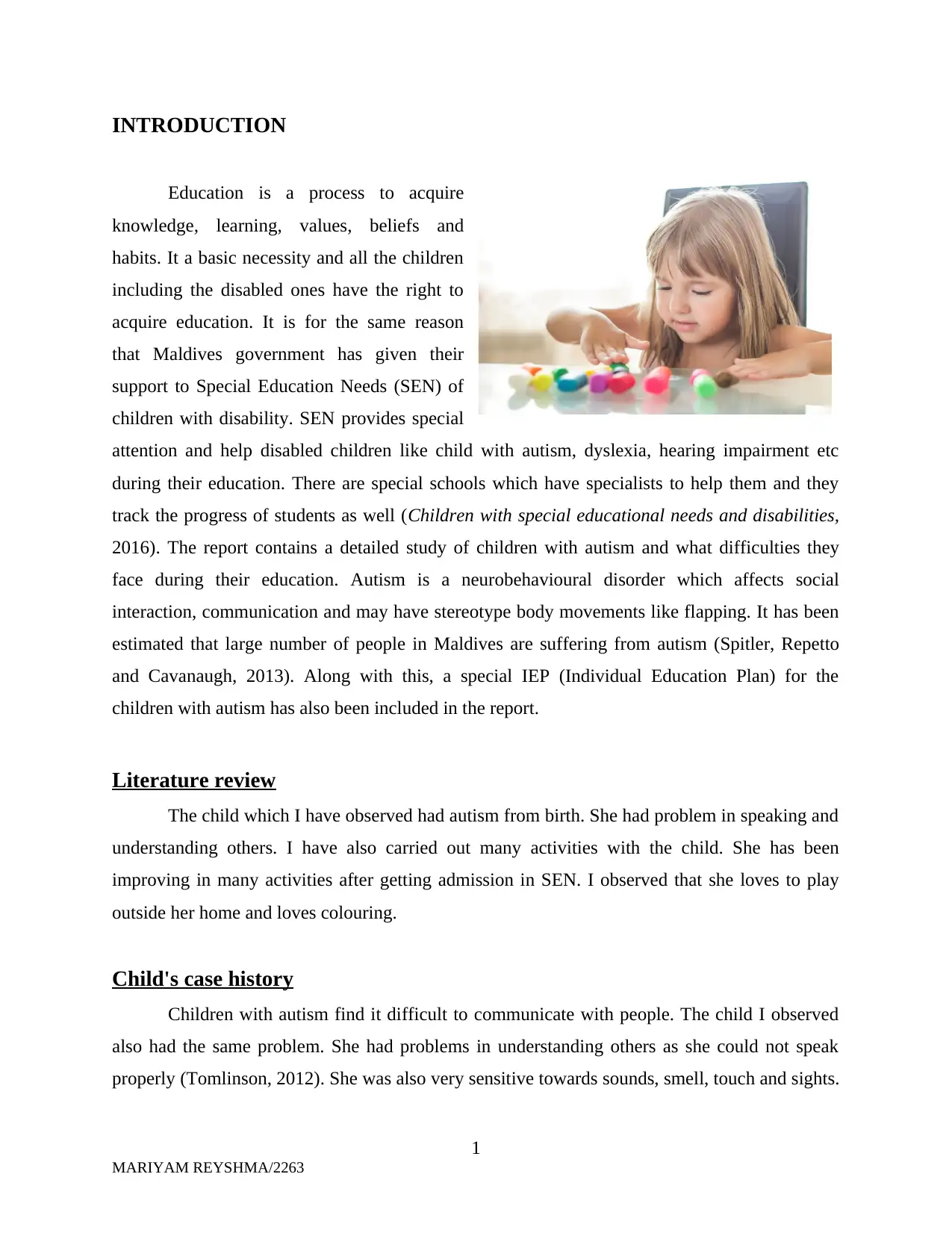
INTRODUCTION
Education is a process to acquire
knowledge, learning, values, beliefs and
habits. It a basic necessity and all the children
including the disabled ones have the right to
acquire education. It is for the same reason
that Maldives government has given their
support to Special Education Needs (SEN) of
children with disability. SEN provides special
attention and help disabled children like child with autism, dyslexia, hearing impairment etc
during their education. There are special schools which have specialists to help them and they
track the progress of students as well (Children with special educational needs and disabilities,
2016). The report contains a detailed study of children with autism and what difficulties they
face during their education. Autism is a neurobehavioural disorder which affects social
interaction, communication and may have stereotype body movements like flapping. It has been
estimated that large number of people in Maldives are suffering from autism (Spitler, Repetto
and Cavanaugh, 2013). Along with this, a special IEP (Individual Education Plan) for the
children with autism has also been included in the report.
Literature review
The child which I have observed had autism from birth. She had problem in speaking and
understanding others. I have also carried out many activities with the child. She has been
improving in many activities after getting admission in SEN. I observed that she loves to play
outside her home and loves colouring.
Child's case history
Children with autism find it difficult to communicate with people. The child I observed
also had the same problem. She had problems in understanding others as she could not speak
properly (Tomlinson, 2012). She was also very sensitive towards sounds, smell, touch and sights.
1
MARIYAM REYSHMA/2263
Education is a process to acquire
knowledge, learning, values, beliefs and
habits. It a basic necessity and all the children
including the disabled ones have the right to
acquire education. It is for the same reason
that Maldives government has given their
support to Special Education Needs (SEN) of
children with disability. SEN provides special
attention and help disabled children like child with autism, dyslexia, hearing impairment etc
during their education. There are special schools which have specialists to help them and they
track the progress of students as well (Children with special educational needs and disabilities,
2016). The report contains a detailed study of children with autism and what difficulties they
face during their education. Autism is a neurobehavioural disorder which affects social
interaction, communication and may have stereotype body movements like flapping. It has been
estimated that large number of people in Maldives are suffering from autism (Spitler, Repetto
and Cavanaugh, 2013). Along with this, a special IEP (Individual Education Plan) for the
children with autism has also been included in the report.
Literature review
The child which I have observed had autism from birth. She had problem in speaking and
understanding others. I have also carried out many activities with the child. She has been
improving in many activities after getting admission in SEN. I observed that she loves to play
outside her home and loves colouring.
Child's case history
Children with autism find it difficult to communicate with people. The child I observed
also had the same problem. She had problems in understanding others as she could not speak
properly (Tomlinson, 2012). She was also very sensitive towards sounds, smell, touch and sights.
1
MARIYAM REYSHMA/2263
⊘ This is a preview!⊘
Do you want full access?
Subscribe today to unlock all pages.

Trusted by 1+ million students worldwide
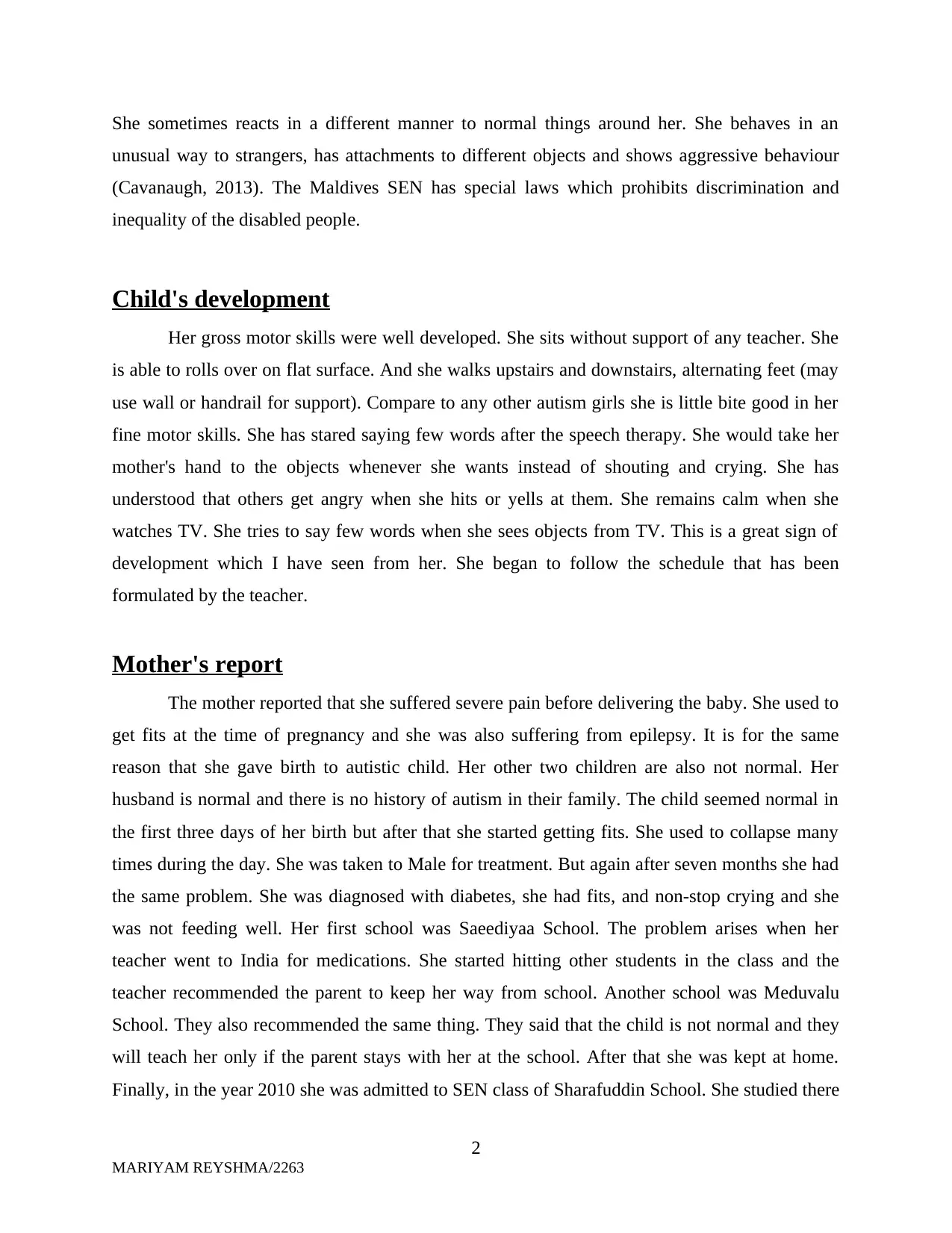
She sometimes reacts in a different manner to normal things around her. She behaves in an
unusual way to strangers, has attachments to different objects and shows aggressive behaviour
(Cavanaugh, 2013). The Maldives SEN has special laws which prohibits discrimination and
inequality of the disabled people.
Child's development
Her gross motor skills were well developed. She sits without support of any teacher. She
is able to rolls over on flat surface. And she walks upstairs and downstairs, alternating feet (may
use wall or handrail for support). Compare to any other autism girls she is little bite good in her
fine motor skills. She has stared saying few words after the speech therapy. She would take her
mother's hand to the objects whenever she wants instead of shouting and crying. She has
understood that others get angry when she hits or yells at them. She remains calm when she
watches TV. She tries to say few words when she sees objects from TV. This is a great sign of
development which I have seen from her. She began to follow the schedule that has been
formulated by the teacher.
Mother's report
The mother reported that she suffered severe pain before delivering the baby. She used to
get fits at the time of pregnancy and she was also suffering from epilepsy. It is for the same
reason that she gave birth to autistic child. Her other two children are also not normal. Her
husband is normal and there is no history of autism in their family. The child seemed normal in
the first three days of her birth but after that she started getting fits. She used to collapse many
times during the day. She was taken to Male for treatment. But again after seven months she had
the same problem. She was diagnosed with diabetes, she had fits, and non-stop crying and she
was not feeding well. Her first school was Saeediyaa School. The problem arises when her
teacher went to India for medications. She started hitting other students in the class and the
teacher recommended the parent to keep her way from school. Another school was Meduvalu
School. They also recommended the same thing. They said that the child is not normal and they
will teach her only if the parent stays with her at the school. After that she was kept at home.
Finally, in the year 2010 she was admitted to SEN class of Sharafuddin School. She studied there
2
MARIYAM REYSHMA/2263
unusual way to strangers, has attachments to different objects and shows aggressive behaviour
(Cavanaugh, 2013). The Maldives SEN has special laws which prohibits discrimination and
inequality of the disabled people.
Child's development
Her gross motor skills were well developed. She sits without support of any teacher. She
is able to rolls over on flat surface. And she walks upstairs and downstairs, alternating feet (may
use wall or handrail for support). Compare to any other autism girls she is little bite good in her
fine motor skills. She has stared saying few words after the speech therapy. She would take her
mother's hand to the objects whenever she wants instead of shouting and crying. She has
understood that others get angry when she hits or yells at them. She remains calm when she
watches TV. She tries to say few words when she sees objects from TV. This is a great sign of
development which I have seen from her. She began to follow the schedule that has been
formulated by the teacher.
Mother's report
The mother reported that she suffered severe pain before delivering the baby. She used to
get fits at the time of pregnancy and she was also suffering from epilepsy. It is for the same
reason that she gave birth to autistic child. Her other two children are also not normal. Her
husband is normal and there is no history of autism in their family. The child seemed normal in
the first three days of her birth but after that she started getting fits. She used to collapse many
times during the day. She was taken to Male for treatment. But again after seven months she had
the same problem. She was diagnosed with diabetes, she had fits, and non-stop crying and she
was not feeding well. Her first school was Saeediyaa School. The problem arises when her
teacher went to India for medications. She started hitting other students in the class and the
teacher recommended the parent to keep her way from school. Another school was Meduvalu
School. They also recommended the same thing. They said that the child is not normal and they
will teach her only if the parent stays with her at the school. After that she was kept at home.
Finally, in the year 2010 she was admitted to SEN class of Sharafuddin School. She studied there
2
MARIYAM REYSHMA/2263
Paraphrase This Document
Need a fresh take? Get an instant paraphrase of this document with our AI Paraphraser

for more than 5 years. Earlier she used to shout if she wanted something but now she takes her
mother's hand to that object instead of yelling and crying.
The causes, weaknesses and difficulties faced by children with autism
Causes
Autism is a genetic disorder and it is caused by the genes which are vulnerable to develop
this disease. It can be develop because of the advance age of any of the parent. The child whom I
observed had the similar problem. It was a genetic disorder which affected her brain. The doctors
believed that it was developed due to epilepsy that her mother had at the time of pregnancy
(Communication development in child with autism, 2011). Her family had no history of autism.
Her mother had epilepsy and she used to get fits at the time of pregnancy. Her husband is
completely normal person.
Strengths
Autism kids can be exceptionally honest and loyal. Many of the autistic children like to
paint and draw (Mann, 2013). The child whom I have observed was really good at drawing,
colouring and memorizing things. This is her own area of interest and she has been above
average in this field. She has the ability to concentrate on narrow topics of her interest. She
understand songs, conversations in movies and the words. She also displays a variety of
emotions.
Weaknesses
Children with autism have uneven skill set and may find difficulty in doing normal day
work (Chu and Zhang, 2015). The girl I observed had communication problems. She cannot
speak in a clear language. She has problems in understanding the emotional state of others. She
remains dependent on others for every small thing. Her biggest weakness is social interaction. It
is difficult for her to understand the rules and methods of social interaction and she prefers to
remain alone.
Difficulties
She always needs some extra help from her parents and teachers. She has problem in
reading, writing, school work, understanding information and expressing herself (Mann, 2013).
Not only in school but even outside it she has to face lot of problems. She has difficulty in
3
MARIYAM REYSHMA/2263
mother's hand to that object instead of yelling and crying.
The causes, weaknesses and difficulties faced by children with autism
Causes
Autism is a genetic disorder and it is caused by the genes which are vulnerable to develop
this disease. It can be develop because of the advance age of any of the parent. The child whom I
observed had the similar problem. It was a genetic disorder which affected her brain. The doctors
believed that it was developed due to epilepsy that her mother had at the time of pregnancy
(Communication development in child with autism, 2011). Her family had no history of autism.
Her mother had epilepsy and she used to get fits at the time of pregnancy. Her husband is
completely normal person.
Strengths
Autism kids can be exceptionally honest and loyal. Many of the autistic children like to
paint and draw (Mann, 2013). The child whom I have observed was really good at drawing,
colouring and memorizing things. This is her own area of interest and she has been above
average in this field. She has the ability to concentrate on narrow topics of her interest. She
understand songs, conversations in movies and the words. She also displays a variety of
emotions.
Weaknesses
Children with autism have uneven skill set and may find difficulty in doing normal day
work (Chu and Zhang, 2015). The girl I observed had communication problems. She cannot
speak in a clear language. She has problems in understanding the emotional state of others. She
remains dependent on others for every small thing. Her biggest weakness is social interaction. It
is difficult for her to understand the rules and methods of social interaction and she prefers to
remain alone.
Difficulties
She always needs some extra help from her parents and teachers. She has problem in
reading, writing, school work, understanding information and expressing herself (Mann, 2013).
Not only in school but even outside it she has to face lot of problems. She has difficulty in
3
MARIYAM REYSHMA/2263

making friends and behaving properly in the schools. She has developed a shell around her
because she has limitations in many normal things (Park, Lombardino and Ritter, 2013).
National and international development
There are many organisations in Maldives and in the entire world which are providing
support to people with autism. Autism national fund, International Child Development Centre
(ICDC), National Autistic Society are some national organisations in Maldives which are helping
the people. There many international organisations also like ASD, INCA, Autism Network
International and WHO. The government has also realised the importance of autism child
education and they started many schools to support them (Bobzien and et.al, 2013). The
disability rights, equality and anti-discrimination has given them equal rights in the society.
Autism children are also given speech and language therapies, trainings and psychological
treatments. Parents are also given training and financial support so that proper resources can be
provided to disabled child (Van Naarden Braun and et.al, 2014). Many of the children are given
free medicines, health care facilities and speech therapy in schools. Small children are also given
counselling classes so that they can develop proper communication with others and improve their
interaction. Innovations and technological developments have also helped the disabled children
(Hintermair 2013). The Special Education Schools provides all the necessary support to disabled
children for some extent. The institution like National Autistic Society has many training
courses for the parents whose child is suffering from autism (Theunissen and et.al, 2014). The
national curriculum of Maldives include NCF. It is non discriminatory and it focusses on the
learning and development of autistic child. It ensures that the all the learning needs of the
students are fulfilled. Their talent and aptitudes are properly addressed by the school.
Observation
In the classroom
A child with autism needs constant support from others all the time. She has her own
limitations which makes her different from others. In school, she faces many problems due to her
inability (Jackson and Schatschneider, 2014). The two main observations in the classroom are
that she lacks communication and does not take part in class room activities. The teachers
understand the needs of that particular child. She speaks little and use gestures more to
4
MARIYAM REYSHMA/2263
because she has limitations in many normal things (Park, Lombardino and Ritter, 2013).
National and international development
There are many organisations in Maldives and in the entire world which are providing
support to people with autism. Autism national fund, International Child Development Centre
(ICDC), National Autistic Society are some national organisations in Maldives which are helping
the people. There many international organisations also like ASD, INCA, Autism Network
International and WHO. The government has also realised the importance of autism child
education and they started many schools to support them (Bobzien and et.al, 2013). The
disability rights, equality and anti-discrimination has given them equal rights in the society.
Autism children are also given speech and language therapies, trainings and psychological
treatments. Parents are also given training and financial support so that proper resources can be
provided to disabled child (Van Naarden Braun and et.al, 2014). Many of the children are given
free medicines, health care facilities and speech therapy in schools. Small children are also given
counselling classes so that they can develop proper communication with others and improve their
interaction. Innovations and technological developments have also helped the disabled children
(Hintermair 2013). The Special Education Schools provides all the necessary support to disabled
children for some extent. The institution like National Autistic Society has many training
courses for the parents whose child is suffering from autism (Theunissen and et.al, 2014). The
national curriculum of Maldives include NCF. It is non discriminatory and it focusses on the
learning and development of autistic child. It ensures that the all the learning needs of the
students are fulfilled. Their talent and aptitudes are properly addressed by the school.
Observation
In the classroom
A child with autism needs constant support from others all the time. She has her own
limitations which makes her different from others. In school, she faces many problems due to her
inability (Jackson and Schatschneider, 2014). The two main observations in the classroom are
that she lacks communication and does not take part in class room activities. The teachers
understand the needs of that particular child. She speaks little and use gestures more to
4
MARIYAM REYSHMA/2263
⊘ This is a preview!⊘
Do you want full access?
Subscribe today to unlock all pages.

Trusted by 1+ million students worldwide
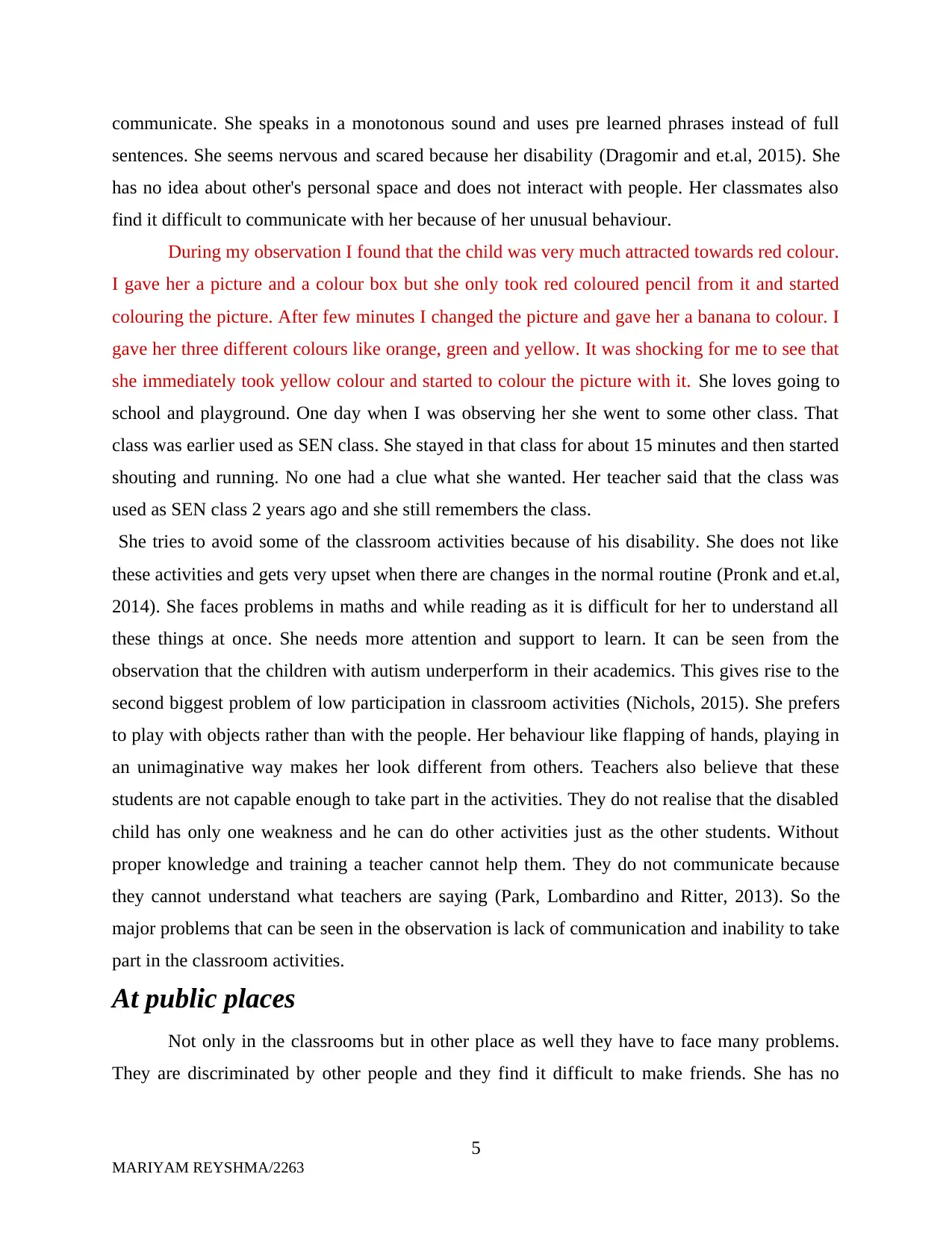
communicate. She speaks in a monotonous sound and uses pre learned phrases instead of full
sentences. She seems nervous and scared because her disability (Dragomir and et.al, 2015). She
has no idea about other's personal space and does not interact with people. Her classmates also
find it difficult to communicate with her because of her unusual behaviour.
During my observation I found that the child was very much attracted towards red colour.
I gave her a picture and a colour box but she only took red coloured pencil from it and started
colouring the picture. After few minutes I changed the picture and gave her a banana to colour. I
gave her three different colours like orange, green and yellow. It was shocking for me to see that
she immediately took yellow colour and started to colour the picture with it. She loves going to
school and playground. One day when I was observing her she went to some other class. That
class was earlier used as SEN class. She stayed in that class for about 15 minutes and then started
shouting and running. No one had a clue what she wanted. Her teacher said that the class was
used as SEN class 2 years ago and she still remembers the class.
She tries to avoid some of the classroom activities because of his disability. She does not like
these activities and gets very upset when there are changes in the normal routine (Pronk and et.al,
2014). She faces problems in maths and while reading as it is difficult for her to understand all
these things at once. She needs more attention and support to learn. It can be seen from the
observation that the children with autism underperform in their academics. This gives rise to the
second biggest problem of low participation in classroom activities (Nichols, 2015). She prefers
to play with objects rather than with the people. Her behaviour like flapping of hands, playing in
an unimaginative way makes her look different from others. Teachers also believe that these
students are not capable enough to take part in the activities. They do not realise that the disabled
child has only one weakness and he can do other activities just as the other students. Without
proper knowledge and training a teacher cannot help them. They do not communicate because
they cannot understand what teachers are saying (Park, Lombardino and Ritter, 2013). So the
major problems that can be seen in the observation is lack of communication and inability to take
part in the classroom activities.
At public places
Not only in the classrooms but in other place as well they have to face many problems.
They are discriminated by other people and they find it difficult to make friends. She has no
5
MARIYAM REYSHMA/2263
sentences. She seems nervous and scared because her disability (Dragomir and et.al, 2015). She
has no idea about other's personal space and does not interact with people. Her classmates also
find it difficult to communicate with her because of her unusual behaviour.
During my observation I found that the child was very much attracted towards red colour.
I gave her a picture and a colour box but she only took red coloured pencil from it and started
colouring the picture. After few minutes I changed the picture and gave her a banana to colour. I
gave her three different colours like orange, green and yellow. It was shocking for me to see that
she immediately took yellow colour and started to colour the picture with it. She loves going to
school and playground. One day when I was observing her she went to some other class. That
class was earlier used as SEN class. She stayed in that class for about 15 minutes and then started
shouting and running. No one had a clue what she wanted. Her teacher said that the class was
used as SEN class 2 years ago and she still remembers the class.
She tries to avoid some of the classroom activities because of his disability. She does not like
these activities and gets very upset when there are changes in the normal routine (Pronk and et.al,
2014). She faces problems in maths and while reading as it is difficult for her to understand all
these things at once. She needs more attention and support to learn. It can be seen from the
observation that the children with autism underperform in their academics. This gives rise to the
second biggest problem of low participation in classroom activities (Nichols, 2015). She prefers
to play with objects rather than with the people. Her behaviour like flapping of hands, playing in
an unimaginative way makes her look different from others. Teachers also believe that these
students are not capable enough to take part in the activities. They do not realise that the disabled
child has only one weakness and he can do other activities just as the other students. Without
proper knowledge and training a teacher cannot help them. They do not communicate because
they cannot understand what teachers are saying (Park, Lombardino and Ritter, 2013). So the
major problems that can be seen in the observation is lack of communication and inability to take
part in the classroom activities.
At public places
Not only in the classrooms but in other place as well they have to face many problems.
They are discriminated by other people and they find it difficult to make friends. She has no
5
MARIYAM REYSHMA/2263
Paraphrase This Document
Need a fresh take? Get an instant paraphrase of this document with our AI Paraphraser
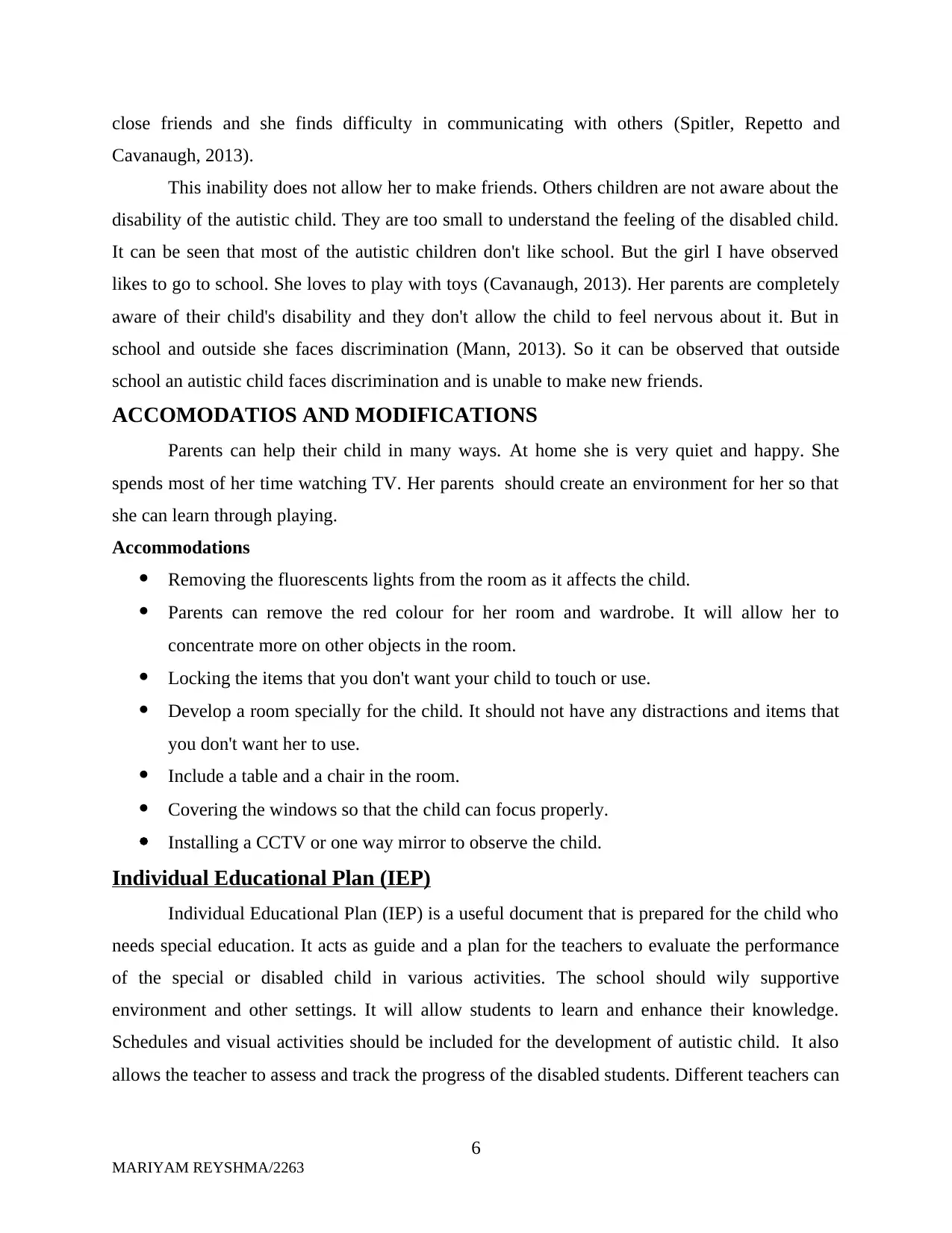
close friends and she finds difficulty in communicating with others (Spitler, Repetto and
Cavanaugh, 2013).
This inability does not allow her to make friends. Others children are not aware about the
disability of the autistic child. They are too small to understand the feeling of the disabled child.
It can be seen that most of the autistic children don't like school. But the girl I have observed
likes to go to school. She loves to play with toys (Cavanaugh, 2013). Her parents are completely
aware of their child's disability and they don't allow the child to feel nervous about it. But in
school and outside she faces discrimination (Mann, 2013). So it can be observed that outside
school an autistic child faces discrimination and is unable to make new friends.
ACCOMODATIOS AND MODIFICATIONS
Parents can help their child in many ways. At home she is very quiet and happy. She
spends most of her time watching TV. Her parents should create an environment for her so that
she can learn through playing.
Accommodations
Removing the fluorescents lights from the room as it affects the child.
Parents can remove the red colour for her room and wardrobe. It will allow her to
concentrate more on other objects in the room.
Locking the items that you don't want your child to touch or use.
Develop a room specially for the child. It should not have any distractions and items that
you don't want her to use.
Include a table and a chair in the room.
Covering the windows so that the child can focus properly.
Installing a CCTV or one way mirror to observe the child.
Individual Educational Plan (IEP)
Individual Educational Plan (IEP) is a useful document that is prepared for the child who
needs special education. It acts as guide and a plan for the teachers to evaluate the performance
of the special or disabled child in various activities. The school should wily supportive
environment and other settings. It will allow students to learn and enhance their knowledge.
Schedules and visual activities should be included for the development of autistic child. It also
allows the teacher to assess and track the progress of the disabled students. Different teachers can
6
MARIYAM REYSHMA/2263
Cavanaugh, 2013).
This inability does not allow her to make friends. Others children are not aware about the
disability of the autistic child. They are too small to understand the feeling of the disabled child.
It can be seen that most of the autistic children don't like school. But the girl I have observed
likes to go to school. She loves to play with toys (Cavanaugh, 2013). Her parents are completely
aware of their child's disability and they don't allow the child to feel nervous about it. But in
school and outside she faces discrimination (Mann, 2013). So it can be observed that outside
school an autistic child faces discrimination and is unable to make new friends.
ACCOMODATIOS AND MODIFICATIONS
Parents can help their child in many ways. At home she is very quiet and happy. She
spends most of her time watching TV. Her parents should create an environment for her so that
she can learn through playing.
Accommodations
Removing the fluorescents lights from the room as it affects the child.
Parents can remove the red colour for her room and wardrobe. It will allow her to
concentrate more on other objects in the room.
Locking the items that you don't want your child to touch or use.
Develop a room specially for the child. It should not have any distractions and items that
you don't want her to use.
Include a table and a chair in the room.
Covering the windows so that the child can focus properly.
Installing a CCTV or one way mirror to observe the child.
Individual Educational Plan (IEP)
Individual Educational Plan (IEP) is a useful document that is prepared for the child who
needs special education. It acts as guide and a plan for the teachers to evaluate the performance
of the special or disabled child in various activities. The school should wily supportive
environment and other settings. It will allow students to learn and enhance their knowledge.
Schedules and visual activities should be included for the development of autistic child. It also
allows the teacher to assess and track the progress of the disabled students. Different teachers can
6
MARIYAM REYSHMA/2263
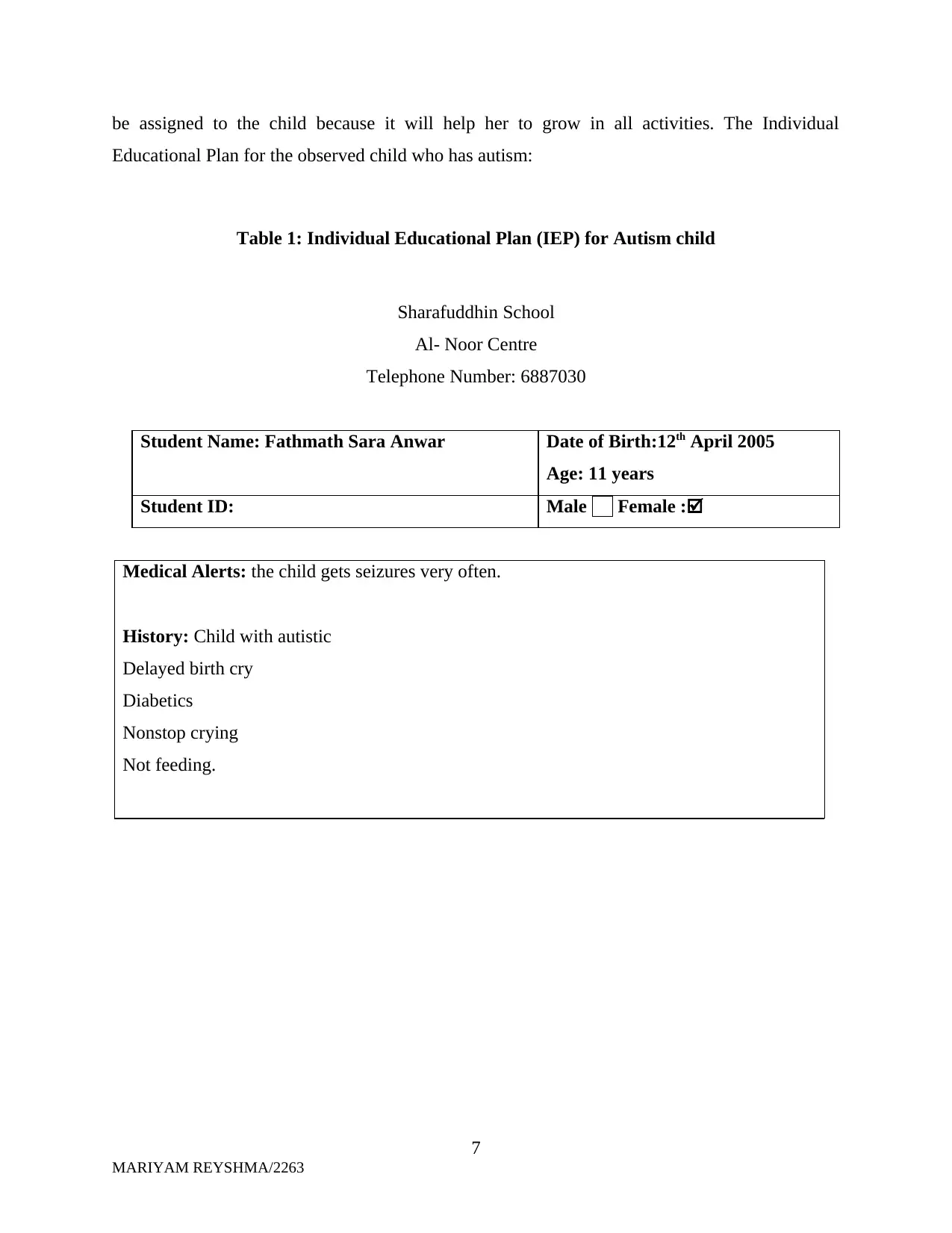
be assigned to the child because it will help her to grow in all activities. The Individual
Educational Plan for the observed child who has autism:
Table 1: Individual Educational Plan (IEP) for Autism child
Sharafuddhin School
Al- Noor Centre
Telephone Number: 6887030
Student Name: Fathmath Sara Anwar Date of Birth:12th April 2005
Age: 11 years
Student ID: Male Female :
Medical Alerts: the child gets seizures very often.
History: Child with autistic
Delayed birth cry
Diabetics
Nonstop crying
Not feeding.
7
MARIYAM REYSHMA/2263
Educational Plan for the observed child who has autism:
Table 1: Individual Educational Plan (IEP) for Autism child
Sharafuddhin School
Al- Noor Centre
Telephone Number: 6887030
Student Name: Fathmath Sara Anwar Date of Birth:12th April 2005
Age: 11 years
Student ID: Male Female :
Medical Alerts: the child gets seizures very often.
History: Child with autistic
Delayed birth cry
Diabetics
Nonstop crying
Not feeding.
7
MARIYAM REYSHMA/2263
⊘ This is a preview!⊘
Do you want full access?
Subscribe today to unlock all pages.

Trusted by 1+ million students worldwide
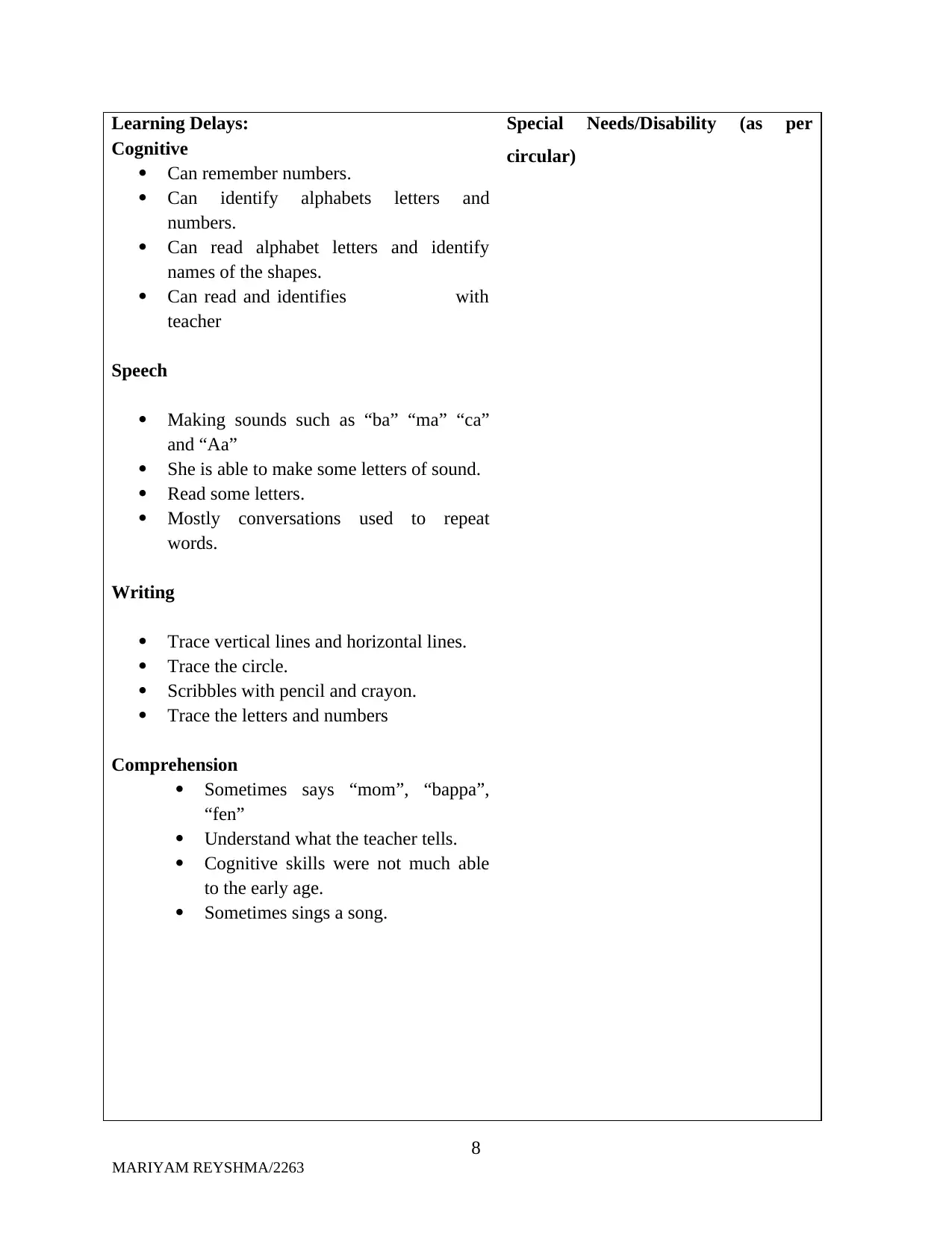
Learning Delays:
Cognitive
Can remember numbers.
Can identify alphabets letters and
numbers.
Can read alphabet letters and identify
names of the shapes.
Can read and identifies with
teacher
Speech
Making sounds such as “ba” “ma” “ca”
and “Aa”
She is able to make some letters of sound.
Read some letters.
Mostly conversations used to repeat
words.
Writing
Trace vertical lines and horizontal lines.
Trace the circle.
Scribbles with pencil and crayon.
Trace the letters and numbers
Comprehension
Sometimes says “mom”, “bappa”,
“fen”
Understand what the teacher tells.
Cognitive skills were not much able
to the early age.
Sometimes sings a song.
Special Needs/Disability (as per
circular)
8
MARIYAM REYSHMA/2263
Cognitive
Can remember numbers.
Can identify alphabets letters and
numbers.
Can read alphabet letters and identify
names of the shapes.
Can read and identifies with
teacher
Speech
Making sounds such as “ba” “ma” “ca”
and “Aa”
She is able to make some letters of sound.
Read some letters.
Mostly conversations used to repeat
words.
Writing
Trace vertical lines and horizontal lines.
Trace the circle.
Scribbles with pencil and crayon.
Trace the letters and numbers
Comprehension
Sometimes says “mom”, “bappa”,
“fen”
Understand what the teacher tells.
Cognitive skills were not much able
to the early age.
Sometimes sings a song.
Special Needs/Disability (as per
circular)
8
MARIYAM REYSHMA/2263
Paraphrase This Document
Need a fresh take? Get an instant paraphrase of this document with our AI Paraphraser
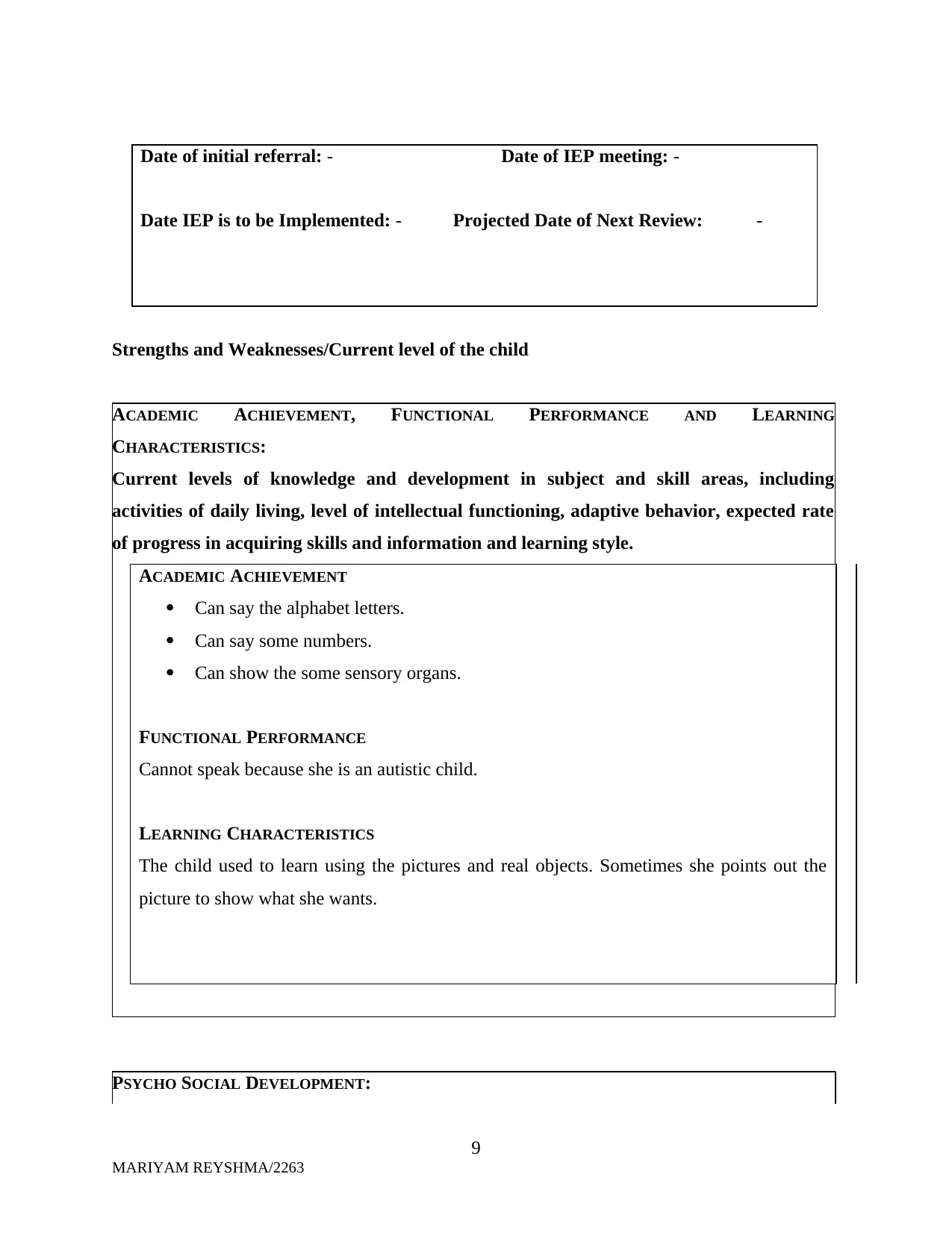
Date of initial referral: - Date of IEP meeting: -
Date IEP is to be Implemented: - Projected Date of Next Review: -
Strengths and Weaknesses/Current level of the child
ACADEMIC ACHIEVEMENT, FUNCTIONAL PERFORMANCE AND LEARNING
CHARACTERISTICS:
Current levels of knowledge and development in subject and skill areas, including
activities of daily living, level of intellectual functioning, adaptive behavior, expected rate
of progress in acquiring skills and information and learning style.
ACADEMIC ACHIEVEMENT
Can say the alphabet letters.
Can say some numbers.
Can show the some sensory organs.
FUNCTIONAL PERFORMANCE
Cannot speak because she is an autistic child.
LEARNING CHARACTERISTICS
The child used to learn using the pictures and real objects. Sometimes she points out the
picture to show what she wants.
PSYCHO SOCIAL DEVELOPMENT:
9
MARIYAM REYSHMA/2263
Date IEP is to be Implemented: - Projected Date of Next Review: -
Strengths and Weaknesses/Current level of the child
ACADEMIC ACHIEVEMENT, FUNCTIONAL PERFORMANCE AND LEARNING
CHARACTERISTICS:
Current levels of knowledge and development in subject and skill areas, including
activities of daily living, level of intellectual functioning, adaptive behavior, expected rate
of progress in acquiring skills and information and learning style.
ACADEMIC ACHIEVEMENT
Can say the alphabet letters.
Can say some numbers.
Can show the some sensory organs.
FUNCTIONAL PERFORMANCE
Cannot speak because she is an autistic child.
LEARNING CHARACTERISTICS
The child used to learn using the pictures and real objects. Sometimes she points out the
picture to show what she wants.
PSYCHO SOCIAL DEVELOPMENT:
9
MARIYAM REYSHMA/2263
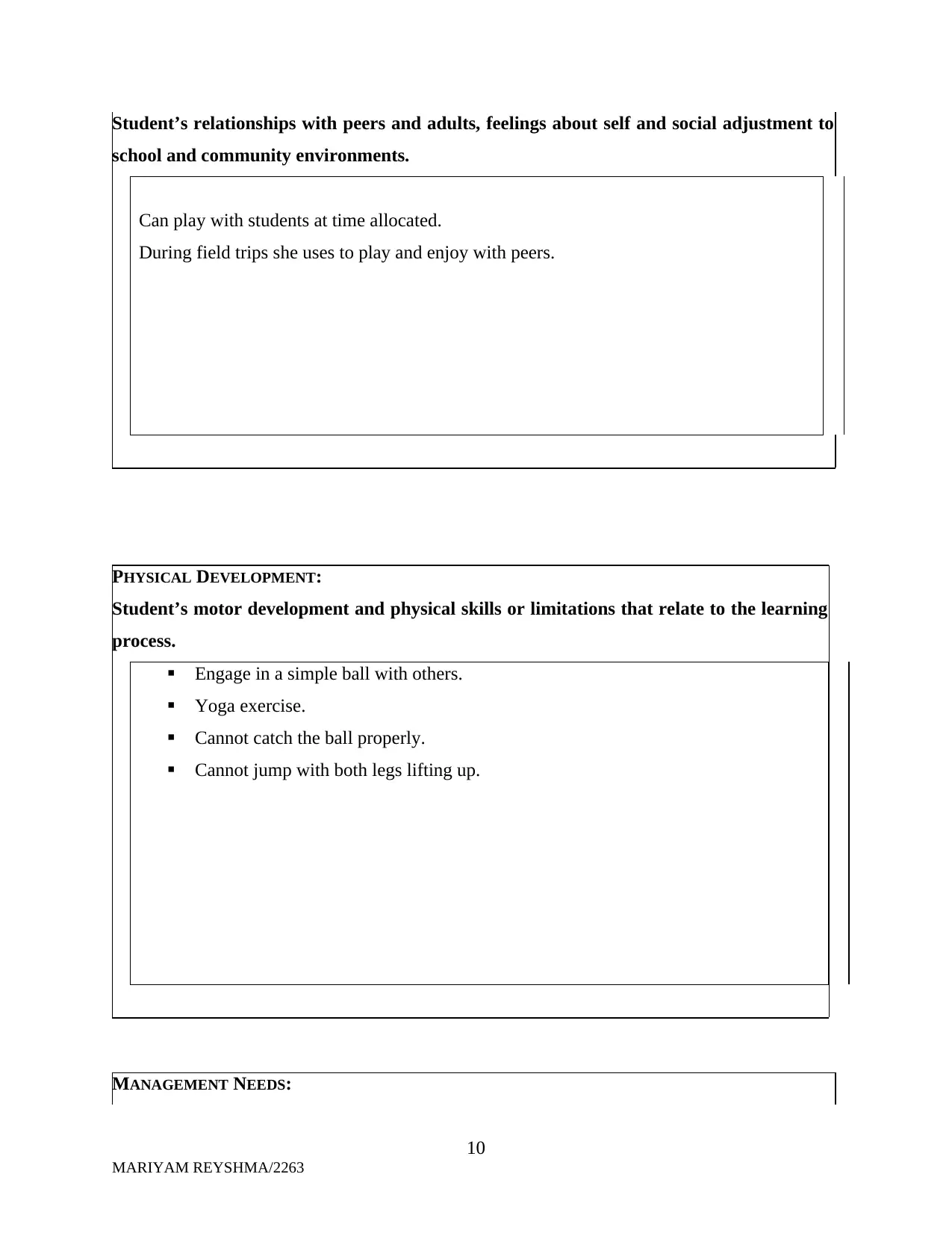
Student’s relationships with peers and adults, feelings about self and social adjustment to
school and community environments.
Can play with students at time allocated.
During field trips she uses to play and enjoy with peers.
PHYSICAL DEVELOPMENT:
Student’s motor development and physical skills or limitations that relate to the learning
process.
Engage in a simple ball with others.
Yoga exercise.
Cannot catch the ball properly.
Cannot jump with both legs lifting up.
MANAGEMENT NEEDS:
10
MARIYAM REYSHMA/2263
school and community environments.
Can play with students at time allocated.
During field trips she uses to play and enjoy with peers.
PHYSICAL DEVELOPMENT:
Student’s motor development and physical skills or limitations that relate to the learning
process.
Engage in a simple ball with others.
Yoga exercise.
Cannot catch the ball properly.
Cannot jump with both legs lifting up.
MANAGEMENT NEEDS:
10
MARIYAM REYSHMA/2263
⊘ This is a preview!⊘
Do you want full access?
Subscribe today to unlock all pages.

Trusted by 1+ million students worldwide
1 out of 38
Related Documents
Your All-in-One AI-Powered Toolkit for Academic Success.
+13062052269
info@desklib.com
Available 24*7 on WhatsApp / Email
![[object Object]](/_next/static/media/star-bottom.7253800d.svg)
Unlock your academic potential
Copyright © 2020–2026 A2Z Services. All Rights Reserved. Developed and managed by ZUCOL.





